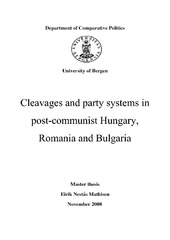| dc.description.abstract | This thesis examines the presence of cleavages and their effect on party systems in post-communist Hungary, Romania and Bulgaria. By using logistic regression models, operationalisations of cleavages from different surveys are used to explain voting behaviour in the the first four post-communist elections in each country. The cleavage patterns that are identified in the quantitative analysis are then used as explanatory variables for the party systems in the three countries. The assumption is that strong and stable cleavage patterns will have led to a more closed structure of competition, and therefore have had a stabilising effect on the party systems.The conceptual approach is influenced by Lipset and Rokkan`s work on Western Europe (Lipset and Rokkan 1967), but the scope is different in the sense that the conditions for cleavage-based party system development is different in the post-communist setting. By distinguishing between horizontal and vertical voter alignment, we open for the importance of cleavages also in environments with high volatility and frequent party replacement.Cleavages are found to matter for voting behaviour in all three countries, and the effect on the party systems is also visible. However, there are substantial differences between the countries. Hungary, where the cleavage structures and the horizontal alignment appears to be the strongest, has the party system with the greatest stability in terms of a closed structure of competition. Bulgaria, where the 2001 election changed the party landscape considerably, is on the other end of the scale, both with regards to cleavage patterns and party system stability. Romania is in an intermediary position, with an apparent connection between certain stable cleavage patterns and certain element of stability in the party system. | en_US |
